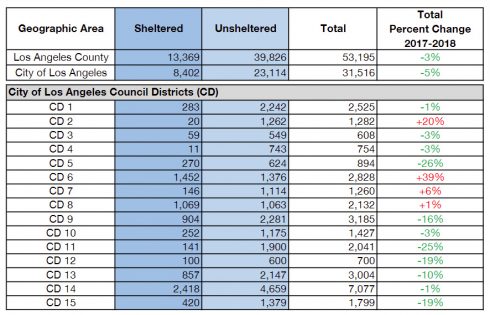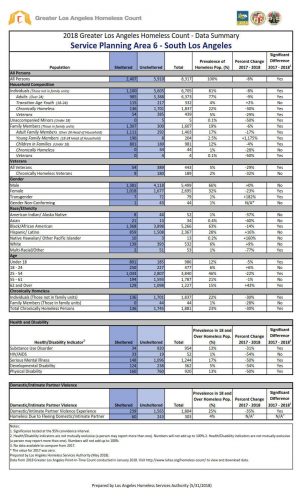LA City and County Celebrate First Successes in Reducing Homelessness
Leslie Evans
About 100 people attended a May 31 invitation-only event outside the PATH (People Assisting the Homeless) offices at 340 N. Madison Avenue where the Los Angeles Homeless Services Authority released the results of its 2018 Los Angeles homeless count. Some 8,500 volunteers over three days in January covered every census tract in the county. The results, along with thousands of interviews with homeless people, have been under analysis by statisticians at USC.
For the first time in four years the numbers went down instead of up. The gains were modest – 3% fewer homeless in the county, 5% fewer in the city – but at least the motion was in the right direction.
By now everyone has seen the gross numbers. For the county, the homeless are down from 55,048 in January 2017 to 53,195 in January 2018; for the city, it was a little better, dropping from 38,138 to 31,516. We will dig into the details further on.
At a small press conference in the PATH building before the main rally, LAHSA’s Executive Director Peter Lynn focused on the L.A. housing crisis as the greatest driver of homelessness: “We housed more homeless people than ever before in 2017: 16,519, up from 10,917 in 2015. But our count showed that first-time homeless people had jumped from 8,044 in 2017 to 9,322 in 2018. Housing costs are the key cause of homelessness. L.A. needs far more affordable housing.”
One reporter asked how LAHSA got figures for how many people were living in the tents and RVs that the volunteers recorded the nights of the January count.
“Our volunteers don’t look in tents and vehicles, just count them,” Lynn replied. “In addition to the street count, we did thousands of street interviews. We asked if people had lived in a vehicle, tent, or make-shift shelter in the last six months, and if so, how many people lived with them. This gave us some figures the USC statistical team could use to extrapolate from the raw number of tents and RVs seen. The interviews this year actually gave us a lower number per vehicle and tent than last year, which reduced our estimate for those locations.”
City and county top brass turned out for the event: Mayor Eric Garcetti, County Supervisors Mark Ridley-Thomas and Janice Hahn, LA City Councilmembers Marqueece Harris-Dawson and Jose Huizar, and Phil Ansell, director of LA County’s Homeless Initiative.
Officials attributed the turnaround to several factors: the influx of funding from Proposition HHH for permanent supportive housing, and Measure H for services; the County’s adoption in February 2016 of a detailed 47 strategies to tackle homelessness; the long-missing coordination of city and county efforts and projects; and the consolidation of the Coordinated Entry System (CES), a countywide computerized intake system that links homeless applications taken at many agencies to a wide variety of services and housing options.

PATH CEO Joel John Roberts at May 31 event.
The outdoor meeting, held in the middle of the short block of Madison Avenue just north of Beverly Blvd., was opened by PATH CEO Joel John Roberts. He pointed to the contrasts of the west and east side of the street where people were standing. The sidewalk on the west contained a long stretch of homeless tents. On the east, hard-hatted workers were on scaffolding completing a six-story building. “That’s our present,” he said, pointing to the tents. “And that is our future,” pointing to the construction under way. It is to be the PATH Metro Villas, containing 187 affordable and permanent supportive apartments in three buildings. He added that the PATH outreach workers know every homeless person for block around by name.

Homeless tents on Madison Avenue north of Beverly Blvd., just opposite PATH offices.

PATH Metro Villas under construction immediately to the east of the PATH offices on Madison Avenue. Will comprise 187 affordable units focused on housing the homeless.
Peter Lynn offered some points about the 2018 count. “The Coordinated Entry System is one of the keys in funneling people into housing no matter what agency they apply to.” Most of the indicators showed some improvement, though some went the other way. “On the positive side, veteran homelessness decreased 18%, from 4,792 in 2017 to 3,910 in 2018. And there was a 16% drop in chronic homelessness (defined as being homeless for one year, or for the equivalent amount of time over three years), from 17,204 to 14,389.”

LAHSA Executive Director Peter Lynn presents the 2018 Homeless Count summary.
Though youth homelessness increased slightly, from 3,233 in 2017 to 3,306 in 2018, “We found more youths were being sheltered this year, from 45% last year to a 53% majority this year.”

Mayor Garcetti highlights the new City-County coordination in the fight to end homelessness. County Supervisor Mark Ridley-Thomas is at his right.
Mayor Garcetti told the crowd that 2017 marked the first time that the city and county closely coordinated their homeless aid projects. “Homelessness is L.A.’s greatest crisis. It is Disfunction Junction. But this year we have seen real progress and real results. Four years ago, we managed to house 8,000 people. Last year, the first full year of HHH and H funding, we housed 16,519. We have hired 500 new people to work on homelessness.
Supervisor Janice Hahn predicted that “Our greatest challenge will not be funding. It will be NIMBYism,” adding, “We are our brother’s keeper.”

County Supervisor Mark Ridley-Thomas calls on the crowd to put on their work cloths and tackle the homeless crisis.
Supervisor Mark Ridley-Thomas made more extensive remarks, beginning by declaring, “In a city as wealthy as Los Angeles, as wealthy as the State of California, homelessness is the moral crisis that will define our legacy.” He exhorted the crowd, “This is no time to rest. Put your work clothes on and work to solve this crisis!”
Measure H, he said, “is doing what it ought to do. We are gearing up to house 45,000 people over the next 5 years.” A skeptic in the audience pointed out that Proposition HHH at $1.2 billion only promised to provide 10,000 permanent supportive housing units in 10 years. Ridley-Thomas responded that a combination of city, county, state, and federal funds, tax breaks for private developers, and other measures will greatly expand the funding available.
Then he turned to relations between the police and the homeless. “It is entirely too costly to try to police our way out of homelessness,” he said. “Our jails are the largest mental health facilities in the country. This requires the retraining of law enforcement. It is not their fault. The training needs to be changed. Sick people should be in a hospital, not be incarcerated.”

CD8 City Councilmember Marqueece Harris-Dawson at May 31 event.
CD8 City Councilmember Marqueece Harris-Dawson spoke briefly. On the issue of criminalization of homelessness by police issuing citations for blocking sidewalks or sleeping on the street, he said that he supported clearing most of these, as they created obstacles for homeless people to get housing or other services. But he added that “incarcerations for homeless violations are miniscule. And being homeless is not a get out of jail free to carry out violent actions.”
A question period followed in which people directed their queries to Mayor Garcetti. One person asked about reports that at the current rate of spending the $1.2 billion HHH funding was too little to build the promised 10,000 units. The Mayor responded, “To get a quick start we have used some HHH funding to pay the full price for the first units we are building. The later units will add matching funds. We expect to leverage $4 to $5 for each dollar of L.A. money further down the road.”
Asked if he agreed that opposition to the proposed homeless housing project in Koreatown was unreasonable NIMBYism, the Mayor replied, “This not NIMBYism, though some of the critics are. I do think this is a good location, but I am willing to look at other places. People ask how you can place homeless housing two blocks from a school. Well, there is a homeless encampment right across from the school today.”
Another asked how 10,000 units could make a big dent in homelessness when there are 31,500 homeless in the city. The Mayor replied, “We don’t need supportive housing for all 31,000 homeless. Many will find other solutions on their own or only need short-term shelter or housing.”
Highlights from the Count
The LAHSA handout at the May 31 event contained only a brief summary of the main points of the findings. The LAHSA website (www.lahsa.org ) has more details, and still more data will be posted there in the future. Following are some of the details, city or countywide, particularly focusing on South Los Angeles, which is of special interest to us.
The homeless are getting older. This year found a 22% increase in homeless 62-years old and older. All other age groups saw a decrease.
They are mostly male: 66%.
6% were fleeing domestic violence
27% said they were mentally ill, while 15% said they have a substance abuse problem. There was a 10% overlap with people who had both issues.
65% have lived in Los Angeles at least 20 years, and 75% were residents of Los Angeles at the time they first became homeless.
Ethnic breakdown
The current demographics of Los Angeles County are 47.7% Latino, 27.8% non-Hispanic whites, 13.7% Asian, 8.7% African American. The remaining 2.1% are Native Americans or self-identified as Multi-Racial.
African American have been and remain vastly overrepresented among the homeless. But the 2018 count found a significant equalizing tendency underway. Latinos were holding steady at 35% of the homeless. Whites were up from 20% to 25%. African American dropped from 40% to 35%. Asians were unchanged at 1%. The other 4% were made up of Native Americans, Pacific Islanders, and Multi-Racial.
Breakdown by City Council District and Detailed Statistics for South Los Angeles (Service Planning Area 6)
Below are two tables from the LAHSA website: Sheltered and unsheltered totals for each of Los Angeles’15 City Council districts, along with percent change since 2017. And the table for one of the county’s 8 Service Planning Areas, in this case, SPA6, South Los Angeles, from the 10 Freeway south to include Compton, Lynwood, and Paramount. This table gives a more detailed breakdown by such factors as household composition, veterans, age, gender, health, and ethnicity.


Comments
Leave a Reply
You must be logged in to post a comment.



